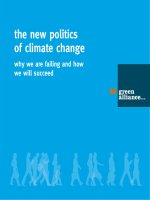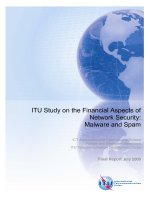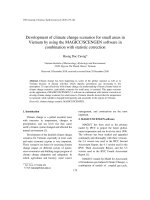Sonia labatt rodney r white carbon finance the financial implications of climate change
Bạn đang xem bản rút gọn của tài liệu. Xem và tải ngay bản đầy đủ của tài liệu tại đây (1.82 MB, 291 trang )
www.ebook3000.com
Carbon
Finance
The Financial Implications
of Climate Change
SONIA LABATT
RODNEY R. WHITE
John Wiley & Sons, Inc.
www.ebook3000.com
www.ebook3000.com
Carbon
Finance
The Financial Implications
of Climate Change
SONIA LABATT
RODNEY R. WHITE
John Wiley & Sons, Inc.
www.ebook3000.com
Copyright c 2007 by Sonia Labatt and Rodney R. White. All rights reserved
Published by John Wiley & Sons, Inc., Hoboken, New Jersey.
Published simultaneously in Canada.
Wiley Bicentennial Logo: Richard J. Pacifico
No part of this publication may be reproduced, stored in a retrieval system, or transmitted in
any form or by any means, electronic, mechanical, photocopying, recording, scanning, or
otherwise, except as permitted under Section 107 or 108 of the 1976 United States Copyright
Act, without either the prior written permission of the Publisher, or authorization through
payment of the appropriate per-copy fee to the Copyright Clearance Center, Inc., 222
Rosewood Drive, Danvers, MA 01923, (978) 750-8400, fax (978) 646-8600, or on the Web
at www.copyright.com. Requests to the Publisher for permission should be addressed to the
Permissions Department, John Wiley & Sons, Inc., 111 River Street, Hoboken, NJ 07030,
(201) 748-6011, fax (201) 748-6008, or online at />Limit of Liability/Disclaimer of Warranty: While the publisher and author have used their
best efforts in preparing this book, they make no representations or warranties with respect to
the accuracy or completeness of the contents of this book and specifically disclaim any implied
warranties of merchantability or fitness for a particular purpose. No warranty may be created
or extended by sales representatives or written sales materials. The advice and strategies
contained herein may not be suitable for your situation. You should consult with a
professional where appropriate. Neither the publisher nor author shall be liable for any loss of
profit or any other commercial damages, including but not limited to special, incidental,
consequential, or other damages.
For general information on our other products and services or for technical support, please
contact our Customer Care Department within the United States at (800) 762-2974, outside
the United States at (317) 572-3993 or fax (317) 572-4002.
Wiley also publishes its books in a variety of electronic formats. Some content that appears in
print may not be available in electronic books. For more information about Wiley products,
visit our Web site at www.wiley.com.
Library of Congress Cataloging-in-Publication Data:
Labatt, Sonia.
Carbon finance: the financial implications of climate change / Sonia Labatt
Rodney R. White.
p. cm. —(Wiley finance series)
‘‘Published simultaneouly in Canada.’’
Includes bibliographical references and index.
ISBN-13: 978-0-471-79467-7 (cloth)
ISBN-10: 0-471-79467-8 (cloth)
1. Emissions trading. 2. Greenhouse gases—Economic aspects. 3.
Environmental economics. I. White, Rodney R. II. Title
HC79.P55L33 2007
363.738 746—dc22
2006033468
ISBN-13 978-0-471-79467-7
Printed in the United States of America
10 9 8 7 6 5 4 3 2 1
www.ebook3000.com
Foreword
fter decades of debate, there is now a clear scientific consensus that
climate change is occurring and that human activities are a major
contributory factor.
Furthermore, the groundbreaking report from Sir Nicholas Stern,
released in October 2006, shows clearly that it is a serious economic
threat, not just a scientific concern. In his comprehensive report for the
U.K. government, the former chief economist at the World Bank describes
climate change as ‘‘the greatest market failure the world has seen.’’
Unabated climate change could cost as much as 20 percent of global
gross domestic product (GDP), he estimates. By acting promptly to avoid
the worst impacts of global warming, however, he says the cost could be
limited to around 1 percent of GDP.
A variety of responses are required, including education and awareness raising, improvements in energy efficiency, and measures to stimulate
the deployment of low-carbon technologies. But, Stern says, a key policy
requirement is carbon pricing—assigning a cost to emissions of greenhouse
gases—through taxation, regulation, and/or emissions trading.
Thanks to the Kyoto Protocol, tools for pricing carbon already exist.
The 1997 treaty, which eventually came into force in February 2005, created
two mechanisms—Joint Implementation (JI) and the Clean Development
Mechanism (CDM)—to encourage investments in projects that reduce
carbon emissions in industrialized and developing countries, respectively.
In addition, it imposed binding emissions limits on industrialized nations
and set out the rules for a global market in emission reductions. Such a
market should ensure that the cheapest reductions are targeted first, thus
minimizing the overall cost of tackling global warming.
To create the foundations for this market, industrialized countries have
each been assigned a limited number of emission allowances and those that
find it difficult to stay within their limit will be allowed to buy allowances
from those with an excess. Also, in return for investing in CDM or JI
projects, these countries will receive emission reduction credits or ‘‘carbon
credits’’ that can be used to offset their own emissions.
The first international attempt to implement such a system was launched
by the European Union in January 2005 and required its 25 member states
to impose emissions caps on individual industrial facilities. As a result,
A
iii
www.ebook3000.com
iv
FOREWORD
greenhouse gas emissions are now a routine risk management issue, and
have a direct impact on the bottom line, for some 5,000 companies across
Europe.
Within 18 months of the program being set up, prices reached ¤30
per metric ton of carbon dioxide (the standard trading unit in the carbon
market) and the value of the market in 2005 was estimated at around
¤6.5 billion, even though a majority of the affected companies have neither
bought nor sold allowances yet. But the EU Emissions Trading Scheme (ETS)
represents a financial exposure even for those companies that have not yet
traded since all installations covered by the scheme face substantial financial
penalties if their emissions exceed their annual allocation of allowances.
In late 2006, average daily volume in the market was around 4 million
allowances, despite an overgenerous allocation process that means, overall,
there will be no shortage in the pilot phase of the program, which runs until
the end of 2007. The rules will be tightened to ensure that there is a genuine
shortage of allowances in Phase II (2008–12).
Other countries and regions, especially in the United States, Australia,
and Japan, are keeping a close eye on the European Union (EU) scheme and
some have plans for similar initiatives of their own. Several other European
countries—notably Norway, Switzerland, and Iceland—have announced
firm plans to join the EU ETS.
In line with the Kyoto Protocol, the EU trading program also allows
companies to buy carbon credits from CDM and JI projects to supplement
their own emission reduction efforts. By mid-2006, more than $6 billion
had been assigned to dedicated ‘‘carbon funds’’ that aim to purchase credits
from such projects to help companies and countries meet their emissions
targets.
According to the World Bank, the overall carbon market—including
the EU ETS, CDM and JI transactions, and other smaller emission reduction
programs—was worth some $22 billion in the first nine months of 2006.
This is more than double the figure for the whole of 2005, and comparable to some established commodity markets, although still very small by
comparison with equity, interest rate, and currency markets.
As trading volumes increase, there will naturally be a growing demand
for insurance products linked to carbon prices. And, as the market expands,
hedge funds and other speculators are showing an interest in trading carbon
credits, which represent a new asset class that is uncorrelated with most
conventional securities.
Corporate emissions of carbon dioxide, methane, and other greenhouse
gases are therefore no longer just the concern of environmental, health,
and safety staff, but are increasingly a matter for senior management, as
www.ebook3000.com
v
Foreword
well as equity analysts, project financiers, insurers, and even mainstream
institutional investors.
In addition to the major European emitters that are subject to the
mandatory requirements of the EU ETS, thousands of other companies
around the world are taking voluntary action to reduce their emissions.
They are generally motivated either by a desire to gain some kind of firstmover advantage ahead of expected legislation, or to boost their reputation
with consumers and shareholders.
The latter are increasingly holding companies to account for their
contribution to climate change. A prime example is the Carbon Disclosure
Project, an initiative backed in 2006 by more than 200 institutional investors
representing some $31 trillion of assets under management—around a third
of the world’s investment capital. The investors sent a questionnaire to
the chairmen of the world’s largest companies asking them to disclose
‘‘investment-relevant information concerning their emissions of greenhouse
gases.’’ Responses are made public and those that fail to respond are named
and shamed.
And, while the EU ETS currently targets only large industrial emitters,
the responsibility for reducing emissions will not stop there. To complement
the trading of emission allowances, carbon taxes are increasingly being
introduced to penalize the use of highly emitting goods and services. In
some countries vehicles are already taxed according to how much carbon
dioxide they emit, and electricity suppliers are obliged to inform consumers
how much of the power they sell comes from low-carbon sources.
There is even talk among European politicians of giving individuals their
own ‘‘carbon allowance’’ each year, which could be credited and debited
according to their purchases, travel choices, and energy consumption.
Sonia Labatt and Rodney White have provided a highly readable
overview of the key developments in this fast-evolving area of carbon
finance. It should be a valuable guide for anyone wishing to understand
the implications of this innovative market-based approach to combating
climate change.
Graham Cooper
Publisher
Environmental Finance magazine
December 2006
www.ebook3000.com
www.ebook3000.com
Contents
Foreword
iii
About the Authors
xiii
Acknowledgments
xv
List of Acronyms
xvii
CHAPTER 1
Introduction
1
Introduction
The Changing Climate
The Scientific Context of Climate Change
The Political Context of Climate Change
Corporate Climate Risk
Regulatory Risk
Physical Risks
Business Risks
Climate Policies
Mitigation Policies
Adaptation Measures
Role of the Financial Services Sector
Conclusion
CHAPTER 2
The Energy Chain
1
3
5
8
11
11
13
14
15
15
19
21
23
27
Introduction
The Energy Chain and the Value Chain
Carbon Policies
Policy Approaches
The Broader Policy Context
National and Local Self-Sufficiency
Impacts of Different Users and Uses on Climate Change
Users: Business, Households, and Government
27
28
32
32
33
33
34
34
vii
www.ebook3000.com
viii
CONTENTS
Uses: Manufacturing, Transportation, Heating, Water,
and Solid Waste
Sources of Energy: Fossil Fuels
Coal
Oil
Gas
Sources of Energy: Nuclear Energy
Sources of Energy: Hydroelectric Power
Sources of Energy: Renewables
Traditional Biomass
Wind Energy
Solar Energy
Tidal Energy and Wave Energy
Modern Biomass and Biofuels
Geothermal Energy
Key Issues
A Hydrogen Economy Based on Fuel Cells?
Carbon Sequestration
Unintended Discharges
Financing the Transformation of the Energy Chain: The Role
of Venture Capital
Conclusion
CHAPTER 3
Regulated and Energy-Intensive Sectors
Introduction
Power Industry
Integrated Oil and Gas Industry
Government Mandates
Physical Capital
Restricted Access to Oil and Gas Reserves
The Coming Age of Gas, and Beyond
Global Concerns Regarding Energy Security
Transportation
Automotive Industry
Factors Affecting Auto Manufacturers’ Carbon Profile
Aviation
Cement
Competitive Implications of Climate Risk in Regulated
and Energy-Intensive Sectors
Conclusion
34
36
36
37
38
39
41
42
44
44
46
47
48
50
50
51
52
53
53
55
57
57
57
65
65
66
66
68
70
71
72
76
80
82
84
87
Contents
CHAPTER 4
The Physical Impacts of Climate Change on the Evolution of Carbon
Finance
Introduction
Physical Impacts on Unregulated Sectors
Water Supply and Treatment
Agriculture
Forestry
Fisheries
Real Property and Production Facilities
Transportation
Tourism
Municipalities
The Built Environment
Physical Impacts on Carbon-Regulated Sectors
Electric Power
Oil and Gas Producers
Financial Services
Banking
Investment
Insurance
Conclusion
CHAPTER 5
Institutional Investors and Climate Change
Introduction
Institutional Investors: Size and Global Reach
Environmental Reporting
Corporations
Institutional Investors
Corporate Environmental Reporting
New Era of Fiduciary Responsibility for Institutional
Investors
Investment Decision Making
Active Engagement
Shareholder Resolutions and Proxy Voting
Mutual Funds
New Momentum in the Corporate World
Barriers to the Financial Consideration of Climate Change
Institutional Investors and Climate Change
ix
89
89
90
90
92
94
96
96
97
97
98
100
103
103
104
105
105
106
106
108
111
111
112
112
112
113
113
116
117
118
120
122
125
127
130
x
CONTENTS
Institutional Investors’ Group on Climate Change
(IIGCC)
Carbon Disclosure Project (CDP)
The Equator Principles
Investor Network on Climate Risk (INCR)
Conclusion
CHAPTER 6
Emissions Trading in Theory and Practice
Introduction
How Carbon Is Traded Now
The Kyoto Protocol
The Chicago Climate Exchange
The European Union Emission Trading Scheme
The Price of Carbon in the EU ETS
Countries outside Europe with Kyoto Caps
Carbon Markets in the United States and Australia
Setting up the Clean Development Mechanism
and Joint Implementation
The Role of Carbon Funds, Carbon Brokers,
and Exchanges
Key Issues
Verification—Protocols for Measuring Emission
Reductions
Controlling the Sale of ‘‘Hot Air’’
The Quality and Price of Carbon Credits
Enforcing Compliance
Integrating the Various Trading Platforms
The CDM Bottleneck
Extending the Time Horizon beyond 2012
Extending Carbon Caps to Uncapped Parties
The Carbon Offset Market
The Role of Insurance in Emissions Trading
Issues for Dispute Resolution
Conclusion
CHAPTER 7
Climate Change and Environmental Security: Individuals,
Communities, Nations
Introduction
Direct Effect of Extreme Weather Events
131
131
134
135
135
137
137
140
140
143
143
148
150
151
153
156
159
159
160
161
161
162
162
163
163
164
165
166
166
169
169
170
Contents
Health Effects of Climate Change
Direct Effects of Temperature Extremes: Heat Waves
and Cold Spells
Indirect Effects of Climate Change: Vector-Borne
Infectious Diseases
Polar Regions
Climate Systems and National Sovereignty
The Gulf Stream and the Thermohaline Current
˜
The El Nino/Southern
Oscillation (ENSO)
Conclusion
CHAPTER 8
Adapting to Adverse and Severe Weather
Introduction
Adverse Weather: The Role of Weather Derivatives
Weather Derivative Instruments
Examples of Weather Derivative Contracts
Current Status of Weather Markets
Constraints on the Weather Derivatives Market
Severe Weather: The Role of Catastrophe Bonds
The Structure of a Catastrophe Bond
Catastrophe Bonds and Carbon Finance
Conclusion
CHAPTER 9
Key Players in the Carbon Markets
by Martin Whittaker, guest author
Introduction
Basic Elements of the Market
EU ETS Trading
Clean Development Mechanism (CDM) and Joint
Implementation (JI) Projects
Intermediaries, Speculators, and Professional Services
Key Private-Sector Players
Compliance Participants
Commercial Banks
Carbon Funds
Speculative Investors
Project Developers and Aggregators, Consultants
Equity Research
Carbon Brokers
xi
173
174
175
179
181
181
183
185
187
187
188
191
192
193
196
198
199
200
201
205
205
206
206
207
208
210
210
210
211
211
213
213
215
xii
CONTENTS
Exchanges
Credit Rating Agencies
Insurers
Key Players from the Public Sector
National Governments
National Business Associations
Multilateral Banks
Information Services
Professional Services
Accounting
Legal
New Horizons for the Carbon Market
Carbon as an Asset Class
Mainstreaming into Project Finance
Conclusion
216
217
217
218
218
219
219
220
221
221
221
222
222
222
223
CHAPTER 10
Carbon Finance: Present Status and Future Prospects
225
Introduction
Trading Volumes in Carbon and Weather Markets
Carbon Markets
Weather Derivatives
What Can Be Traded Where? (and What Cannot?)
Price Discovery
The Evolution of Products for Carbon Finance
Litigation over Responsibility for Climate Change
Is Carbon Finance Likely to Help Us Avert Dangerous Levels
of Climate Change?
Carbon Finance within the Broader Field of Environmental
Finance
Conclusion
225
227
227
228
229
230
231
232
234
235
237
Endnotes
241
Web Sites
245
References
247
Index
263
About the Authors
Sonia Labatt is an associate faculty member at the Centre for Environment,
University of Toronto. She has been engaged in the academic world of
environmental finance through her graduate-level courses at the university,
and in the financial services world as an active investor. Dr. Labatt broadens
her environmental concerns, experience, and commitment through her
association with World Wildlife Fund Canada.
Rodney R. White, Professor of Geography at the University of Toronto,
was director of the university’s Institute for Environmental Studies
1994–1999 and 2000–2005. He is also an Associate Fellow of the Environmental Change Institute at the University of Oxford and a Senior Fellow at
Massey College, University of Toronto. His recent books include Building
the Ecological City and Planning in Cities (with Roger Zetter).
In 2002 Sonia Labatt and Rodney White published Environmental
Finance: A Guide to Environmental Risk Assessment and Financial Products
(Wiley Finance).
Martin Whittaker, Carbon Finance guest author, leads the environmental finance strategy at MissionPoint Capital Partners, a Connecticut-based
private investment firm. Prior to joining MissionPoint, he was part of
the Environmental and Commodity Markets team at Swiss Re Financial
Services. Dr. Whittaker holds a PhD in environmental science from the
University of Edinburgh and an MBA from the University of London. Prevoiusly, he was an adjunct professor at the Unversity of Toronto, where he
taught environmental finance.
xiii
Acknowledgments
While writing this book we have benefited from the knowledge of a number
of people, many of whom have become experts in the new field of carbon
finance. They include: Jane Ambachtsheer (Mercer Investment Counseling),
Dominic Barton (McKinsey & Company), Ann-Marie Brinkman (International Energy Agency), Frances Buckingham (SustainAbility), Valerie
Cooper (Weather Risk Management Association), Renata Christ (Intergovernmental Panel on Climate Change), Julie Desjardins (CICA consultant),
James Evans (RBC Financial Group), Odette Goodall (Endiang Holdings
Inc.), Charles Kennedy (MacDougall, MacDougall & MacTier Inc.), Yann
Kermode (UBS AG), Ian Hart (Pacific Institute), John Lane (Johns Hopkins University Press), Helen Lup (The Economical Insurance Group), Sue
McGeachie (Innovest Strategic Value Advisors), Andrea Moffat (CERES),
Sibyl Nelson (Pew Center on Global Climate Change), Brenda Norris
(Commissioner, Roosevelt Campobello International Park Commission),
Nick Parker (Cleantech Capital Group LLC), Alexander Pohl (HSBC), Jane
Rigby (Environment Canada), Dr. Armin Sandhoeval (Allianz Climate Core
Group), Elizabeth Sandler (Science magazine), Ashraf Sharkawy (Allianz
Global Risks), Gray Taylor (Bennett Jones), William (Bill) Tharp (The
Quantum Leap Company Limited), John Turner (Miller Thomson LLP),
Angelika Wirtz (Munich Re), Alan Willis (Alan Willis and Associates),
Errick Willis (ICF International), and Martin Whittaker (Mission Point
Capital Partners).
Once again, we owe special thanks to Graham Cooper, founding
publisher of the journals Environmental Finance and Carbon Finance, for
his foresight in recognizing the emergence of the field of carbon finance in
anticipation of a carbon-constrained world. For a second time, Graham has
been kind enough to write the foreword to our book.
Finally we recognize our spouses, Sue White and Arthur Labatt, who
offered wise counsel, encouragement, and support, and have shown patience
beyond their call of duty.
Even with all this help, no doubt errors do remain, for which the authors
alone take all responsibility.
Sonia Labatt and Rodney R. White
xv
List of Acronyms
AAUs
ABI
ACEA
AGM
AIM
AMD
ART
CAFE
CalPERS
CalSTERS
CARB
CBOT
CCS
CCSA
CCX
CDD
CDM
CDP
CEC
CEO
CERs
CFIs
CFO
CHP
CICA
CME
COP
Defra
DSRF
assigned amount units
Association of British Insurers
Association des Constructeurs Europ´een d’Automobiles
(Association of European Automobile Manufacturers)
annual general meeting
Alternative Investment Market (London)
Accounts Modernization Directive (U.K.)
alternative risk transfer
Corporate Average Fuel Economy standard (U.S.)
California Public Employees’ Retirement System
California State Teachers’ Retirement System
California Air Resources Board
Chicago Board of Trade
carbon capture and storage
Carbon Capture and Storage Association (U.K.)
Chicago Climate Exchange
cooling degree day
Clean Development Mechanism
Carbon Disclosure Project
Commission of the European Communities
chief executive officer
Certified Emissions Reduction units from the Clean
Development Mechanism (CDM)
Carbon Financial Instruments (at the CCX)
chief financial officer
combined heat and power
Canadian Institute of Chartered Accountants
Chicago Mercantile Exchange
Conference of the Parties: the United Nations Framework
Convention on Climate Change
Department for Environment, Food, and Rural Affairs
(U.K.)
deep southerly return flow
xvii
www.ebook3000.com
xviii
EBITDA
ECX
EEZ
EFET
EH&S
EIB
ENSO
EOR
EPA
ERPA
ERUs
ETS
EUA
EUETS
GAAP
GGCAP
GHGs
GTL
HDD
HEP
HFCs
HOV
IATA
ICE
ICLEI
IET
IETA
IFC
IFIC
IGCC
IIGCC
INCR
IPCC
IPE
IPO
IRRC
ISDA
JAMA
JI
LIST OF ACRONYMS
earnings before interest, taxes, depreciation, and
amortization
European Climate Exchange
Exclusive Economic Zone
European Federation of Energy Traders
environment, health, and safety
European Investment Bank
˜
El Nino/Southern
Oscillation
enhanced oil recovery
Environmental Protection Agency (U.S.)
Emission Reduction Purchase Agreement
emission reduction units from Joint Implementation (JI)
emissions trading scheme
European Union Allowances
European Union Emissions Trading Scheme
General Agreement on Accounting Practices
Greenhouse Gas Credit Aggregation Pool (Natsource)
greenhouse gases
gas-to-liquid (refinery process)
heating degree day
hydro-electric power
hydrofluorocarbons
high occupancy vehicles (road lanes reserved for)
International Air Transport Association
internal combustion engine
International Council for Local Environmental Initiatives
international emissions trading
International Emissions Trading Association
International Finance Corporation
Investment Fund Institute of Canada
integrated gasification combined cycle (power station)
Institutional Investors’ Group on Climate Change
Investor Network on Climate Risk
Intergovernmental Panel on Climate Change
International Petroleum Exchange
initial public offering
Investor Responsibility Research Center
International Swaps and Derivatives Association
Japan Automobile Manufacturers’ Association
Joint Implementation
List of Acronyms
KAMA
LEED
LFG
MAC
LIBOR
LNG
MCCF
MD&A
MOP
MW
NAIC
NGO
NOx
NAP
OECD
OMERS
OPEC
OTC
PDI
REC
RGGI
SEC
SMUD
SO2
SRI
SUV
TBE
THC
TIAA-CREF
UKCIP
UNEP
UNEPFI
UNFCCC
USS
VAT
WAIS
xix
Korea Automobile Manufacturers’ Association
Leadership in Energy and Environmental Design
landfill gas
marginal abatement cost
London Interbank Offered Rate
liquified natural gas
Multilateral Carbon Credit Fund
management’s discussion and analysis
meeting of the Parties to the Kyoto Protocol
megawatt
National Association of Insurance Commissioners (U.S.)
non-governmental organization
nitrogen oxides
National Action Plan (EU ETS)
Organisation for Economic Co-operation and
Development
Ontario Municipal Employee Retirement System
Ogranisation of Petroleum-exporting Countries
over the counter (trading)
power dissipation index
Renewable Energy Certificate
Regional Greenhouse Gas Initiative
Securities and Exchange Commission (U.S.)
Sacramento Municipal Utility Department
sulfur dioxide
socially responsible investment
sports utility vehicle
tick-borne encephalitis
thermohaline circulation
Teachers’ Insurance and Annuity Association—College
Retirement Equities Fund
United Kingdom Climate Impact Programme
United Nations Environment Programme
United Nations Environment Programme Financial
Initiative
United Nations Framework Convention on Climate
Change
Universities’ Superannuation Scheme (U.K.)
value-added tax
Western Antarctic Ice Sheet
xx
WBCSD
WMO
WNV
WRI
WRMA
ZEV
LIST OF ACRONYMS
World Business Council for Sustainable Development
World Meteorological Organization
West Nile virus
World Resources Institute
Weather Risk Management Association
zero-emission vehicle (California’s mandate)
CHAPTER
1
Introduction
One thing that we’ve really broadly started to appreciate more is
that climate is not an environmental issue. Climate change is a
systemic and fundamental issue about the way our economics
work and the way we get our energy.
—Robert Bradley, World Resources Institute
INTRODUCTION
Environmental concerns in general, and issues regarding climate change in
particular, are moving from the realm of corporate Environment, Health,
and Safety (EH&S) personnel, into that of corporate financial strategy,
which involves chief executive officers (CEOs) and chief financial officers
(CFOs) as well as boards of directors. The pace of this transformation has
left few unaffected, from companies and cities managing their greenhouse
gas emissions to equity and debt analysts paying close attention to climate
liabilities along with physical concerns regarding the potential impacts of
climate change patterns.
Carbon finance explores the financial implications of living in a carbonconstrained world—a world in which emissions of carbon dioxide and
other greenhouse gases1 carry a price. Thus, carbon finance:
■
■
■
Represents one specific dimension of environmental finance.
Explores the financial risks and opportunities associated with a carbonconstrained society.
Anticipates the availability and use of market-based instruments that are
capable of transferring environmental risk and achieving environmental
objectives.
1
2
CARBON FINANCE
This conveys a more inclusive meaning than the one adopted by the
World Bank:
Carbon finance is the term applied to the resources provided to a
project to purchase greenhouse gas emissions reductions. (World
Bank 2006)
Our broader definition is consistent with the usage adopted by the
journal Carbon Finance, which covers ‘‘market solutions to climate change.’’
A variety of drivers influence the discipline of carbon finance, which in
turn takes many forms (Figure 1.1). It is shaped by national and international regulations, which require producers and consumers to emit fewer
greenhouse gases (GHGs), or to pay the price. Some of these regulations had
their origin in an earlier piece of legislation designed to curb air pollution,
conserve energy, and promote renewable energy. Others have been created
by international agreements such as the Kyoto Protocol and the European
Union Emission Trading Scheme.
Government
Policies
Price of Carbon
Corporations
New (Clean)
Technologies
New Consumer
Products
Investors
New Financial
Products
CARBON FINANCE
Alternative Investment
Opportunities
(Strategies)
Consumer
Pressures
Resource Scarcity
and Security
Carbon
Exchanges
Environmental
Damage
FIGURE 1.1 Carbon Finance: Its drivers and markets









